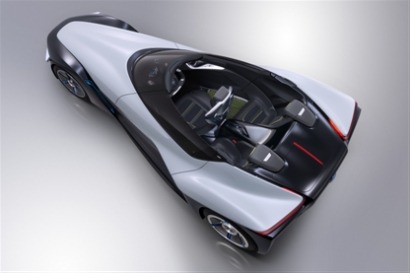
The company developed the vehicle in order to give both the driver and passengers a new, sustainable and exhilarating driving experience. It has a unique architecture which Nissan describes as ‘targeting the visionary individual’ and incorporates a ‘pioneering’ spirit that distinguishes it from anything yet envisioned for EV’s.
“The goal was to revolutionise the architecture of the vehicle to provoke new emotions, provide new value and make visible for consumers how Zero Emissions can help redefine our conception of vehicle basics” said Francois Bancon, division general manager of Product Strategy and Product Planning at Nissan.
The car has a narrow front track which is designed to challenge the orthodoxy of car design that the company says has dominated the roads since the earliest days of the internal combustion engine. The concept has its roots in the aerial images of a soaring, silent, glider and the triangular shape of a high performance "swept wing" aircraft. This means that the main developmental focus was aerodynamics in order to achieve low drag and generating a road-hugging downforce.
“BladeGlider was conceived around delivering a glider-like exhilaration that echoes its lightweight, downsized hyper-efficient aerodynamic form” said Shiro Nakamura, Nissan's senior vice president and chief creative officer. “This design is more than revolutionary; it's transformational, applying our most advanced electric drive-train technology and racetrack-inspired styling in the service of a new dimension of shared driving pleasure.”
The BladeGliders front wheels are set close together in order to reduce drag and enhance manoeuvrability for high-G cornering power. This in turn is assisted by a 30/70 front/rear weight distribution ratio while the aerodynamic downforce is created by a highly rigid yet lightweight carbon-fibre underbody. In-wheel motors provide rear-wheel propulsion with independent motor management, while also contributing to freedom of upper body design and space-efficient packaging. Once the BladeGlider matures into a production car, it will be the first time Nissan has used in-wheel motors.
The car’s electric motors employ lithium-ion batteries which have already demonstrated proven performance in the Nissan LEAF EV. In the BladeGlider the battery modules are mounted low and towards the rear to enhance stability and handling.
The cockpit inside the car’s canopy seats three occupants in a triangular configuration with the driver sat centre-forward. The steering wheel is like that inside an aircraft and the dashboard incorporates state-of-the-art instrumentation technology which includes an IT system displaying relief maps and atmospheric data.
“I think that the excitement of the racing car should be mirrored in the excitement of driving the road car” said Ben Bowlby, director of Nissan Motorsport Innovation, who has supported the BladeGlider's development. “I think there are elements we can bring from the race track to make these future road cars more exciting, more fulfilling and give greater driving pleasure.”
For additional information:

